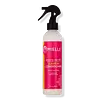What's inside
What's inside
 Key Ingredients
Key Ingredients

 Benefits
Benefits

 Concerns
Concerns

 Ingredients Side-by-side
Ingredients Side-by-side

Water
Skin ConditioningSorbitol
HumectantAcrylates/Steareth-20 Methacrylate Copolymer
Prunus Amygdalus Dulcis Oil
Skin ConditioningGlycerin
HumectantAminomethyl Propanol
BufferingPolysorbate 20
EmulsifyingCarbomer
Emulsion StabilisingMentha Piperita Oil
MaskingRosmarinus Officinalis Leaf Oil
MaskingDisodium EDTA
Aloe Barbadensis Leaf Juice
Skin ConditioningPanthenol
Skin ConditioningOrbignya Oleifera Seed Oil
EmollientZingiber Officinale Root Oil
MaskingCocos Nucifera Oil
MaskingEquisetum Arvense Extract
AstringentLawsonia Inermis Extract
AntimicrobialRosmarinus Officinalis Extract
AntimicrobialAnthemis Nobilis Flower Extract
MaskingSymphytum Officinale Callus Culture Extract
Skin ConditioningHumulus Lupulus Extract
AntimicrobialUrtica Dioica Extract
AstringentHoney
HumectantBiotin
AntiseborrhoeicPhenoxyethanol
PreservativeBenzoic Acid
MaskingEthylhexylglycerin
Skin ConditioningGlycereth-2 Cocoate
EmulsifyingWater, Sorbitol, Acrylates/Steareth-20 Methacrylate Copolymer, Prunus Amygdalus Dulcis Oil, Glycerin, Aminomethyl Propanol, Polysorbate 20, Carbomer, Mentha Piperita Oil, Rosmarinus Officinalis Leaf Oil, Disodium EDTA, Aloe Barbadensis Leaf Juice, Panthenol, Orbignya Oleifera Seed Oil, Zingiber Officinale Root Oil, Cocos Nucifera Oil, Equisetum Arvense Extract, Lawsonia Inermis Extract, Rosmarinus Officinalis Extract, Anthemis Nobilis Flower Extract, Symphytum Officinale Callus Culture Extract, Humulus Lupulus Extract, Urtica Dioica Extract, Honey, Biotin, Phenoxyethanol, Benzoic Acid, Ethylhexylglycerin, Glycereth-2 Cocoate
Water
Skin ConditioningCamellia Sinensis Extract
AntioxidantCocos Nucifera Oil
MaskingCetyl Alcohol
EmollientCetearyl Alcohol
EmollientStearalkonium Chloride
PreservativeSimmondsia Chinensis Seed Oil
EmollientOlea Europaea Fruit Oil
MaskingGlycerin
HumectantDelta-Decalactone
MaskingArgania Spinosa Kernel Oil
EmollientMentha Piperita Leaf Extract
Skin ConditioningYucca Schidigera Root Extract
Skin ConditioningEquisetum Arvense Leaf Extract
AstringentUrtica Dioica Leaf Extract
Skin ConditioningMelissa Officinalis Leaf Extract
Skin ConditioningHydrolyzed Silk
HumectantPotassium Sorbate
PreservativeDiethyl Phthalate
MaskingCitrus Grandis Seed Extract
AstringentCyamopsis Tetragonoloba Gum
Emulsion StabilisingCitric Acid
BufferingWater, Camellia Sinensis Extract, Cocos Nucifera Oil, Cetyl Alcohol, Cetearyl Alcohol, Stearalkonium Chloride, Simmondsia Chinensis Seed Oil, Olea Europaea Fruit Oil, Glycerin, Delta-Decalactone, Argania Spinosa Kernel Oil, Mentha Piperita Leaf Extract, Yucca Schidigera Root Extract, Equisetum Arvense Leaf Extract, Urtica Dioica Leaf Extract, Melissa Officinalis Leaf Extract, Hydrolyzed Silk, Potassium Sorbate, Diethyl Phthalate, Citrus Grandis Seed Extract, Cyamopsis Tetragonoloba Gum, Citric Acid
Ingredients Explained
These ingredients are found in both products.
Ingredients higher up in an ingredient list are typically present in a larger amount.
Cocos Nucifera Oil is obtained from the kernels of the coconut fruit. In other words, this is coconut oil.
Coconut Oil is rich in fatty acids with lauric acid making up the majority of these. It also contains linoleic acid. Due to this high fatty acid content, coconut oil helps trap moisture and soften skin.
Despite being antibacterial, coconut oil may not be great for acne-prone skin. It is comedogenic and may clog pores. This ingredient may not be safe for malassezia or fungal acne.
Note: Coconut Oil should not replace your sunscreen for UV protection. Studies show it only blocks about 20% of UV.
This oil is non-volatile and has a light scent.
The term 'fragrance' is not regulated in many countries. In many cases, it is up to the brand to define this term. For instance, many brands choose to label themselves as "fragrance-free" because they are not using synthetic fragrances. However, their products may still contain ingredients such as essential oils that are considered a fragrance.
Learn more about Cocos Nucifera OilGlycerin is already naturally found in your skin. It helps moisturize and protect your skin.
A study from 2016 found glycerin to be more effective as a humectant than AHAs and hyaluronic acid.
As a humectant, it helps the skin stay hydrated by pulling moisture to your skin. The low molecular weight of glycerin allows it to pull moisture into the deeper layers of your skin.
Hydrated skin improves your skin barrier; Your skin barrier helps protect against irritants and bacteria.
Glycerin has also been found to have antimicrobial and antiviral properties. Due to these properties, glycerin is often used in wound and burn treatments.
In cosmetics, glycerin is usually derived from plants such as soybean or palm. However, it can also be sourced from animals, such as tallow or animal fat.
This ingredient is organic, colorless, odorless, and non-toxic.
Glycerin is the name for this ingredient in American English. British English uses Glycerol/Glycerine.
Learn more about GlycerinWater. It's the most common cosmetic ingredient of all. You'll usually see it at the top of ingredient lists, meaning that it makes up the largest part of the product.
So why is it so popular? Water most often acts as a solvent - this means that it helps dissolve other ingredients into the formulation.
You'll also recognize water as that liquid we all need to stay alive. If you see this, drink a glass of water. Stay hydrated!
Learn more about Water